About the classic old processor Core i5-7500, the author has previously shared its latest gaming performance evaluation in the previous nostalgic series, not equipped with other models of dedicated graphics cards.
The result is that the CPU usage of Core i5-7500 is very high, almost fully loaded, and relatively strenuous, but the average frame rate of most mainstream games can reach over 40FPS, playing smoothly without any issues. If the requirements are not high, this processor can still hold for about another two years.
There is a popular saying in the digital circle, “Unplug the discrete graphics card to improve gaming performance.” Below, the author will take a different approach and unplug the mid-to-high-end dedicated graphics card to see the integrated HD630 gaming performance of the Core i5-7500.
01
Parameter Review of Core i5-7500
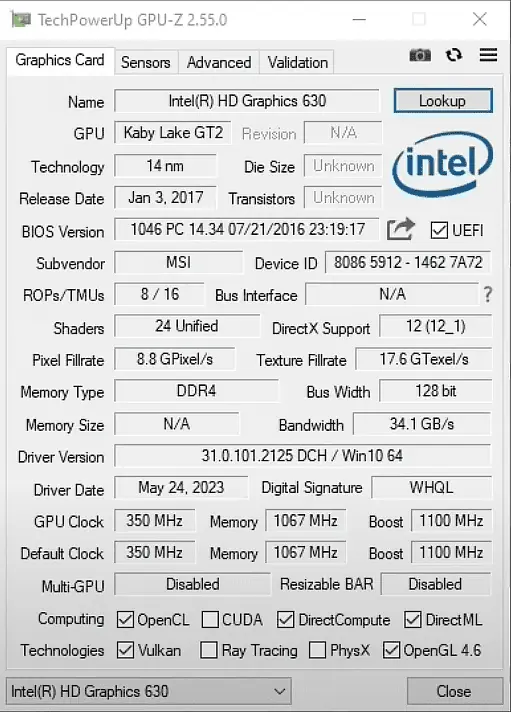
The Core i5-7500 was released on January 3, 2017, using a 14-nanometer process. It features 4 cores and 4 threads, with a base operating frequency of 3.4 GHz and a maximum operating frequency of 3.8 GHz. Equipped with 6MB of smart cache, it integrates HD Graphics 630, has a standard power consumption of 65W, and was suggested to retail at $192.
02
Test Platform Configuration of Core i5-7500
The main configuration is as follows:
- Processor: Core i5-7500
- Motherboard: MSI Z270 GAMING
- Memory: 16GB DDR4 2666MHz
- Graphics Card: Integrated HD Graphics 630
- Hard Drive: XPG S40G 512GB by ADATA
03
Game Performance Testing of Core i5-7500
As an older integrated graphics unit, it shouldn’t be subjected to overly demanding requirements. There’s no need to challenge it with heavyweight games like “The Last of Us Part I” and “Starfield” at 1080P high quality; that would be unrealistic. The main focus of this article is nostalgia, so let’s appropriately reduce the difficulty for it.
Below are tests conducted on seven games, all run in 720P quality mode, assessing some classic older games.
① The First Game is “Assassin’s Creed 4: Black Flag”
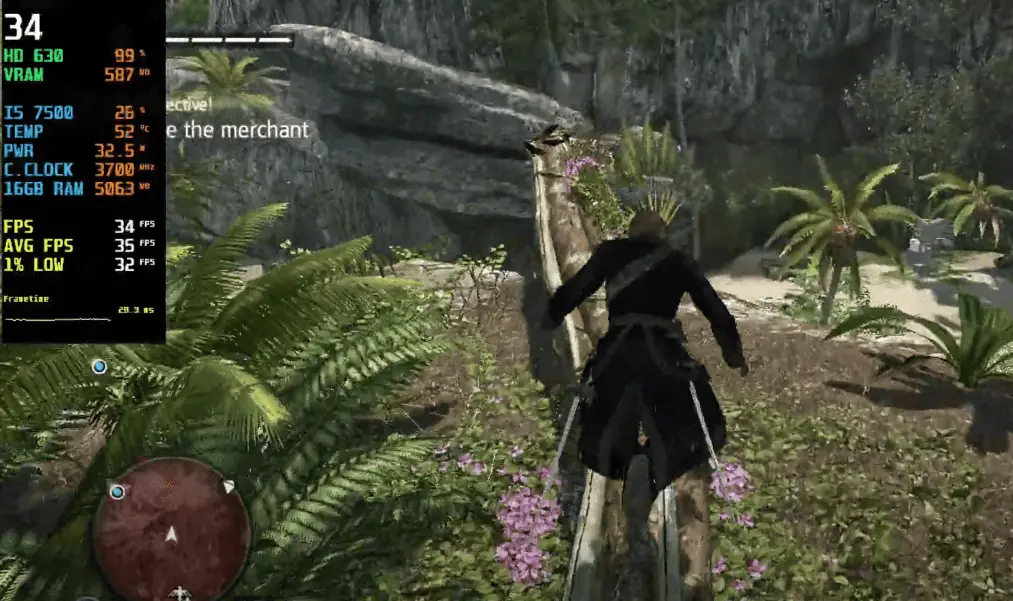
- Average Frame Rate: 35 FPS
- Minimum Instantaneous Frame Rate: 32 FPS
- Frame Time: 28.3ms
- CPU usage: 26%
- Power Consumption: 325W
- CPU Temperature: 52 degrees
- Memory usage: 5.1GB
- GPU usage: 99%
- VRAM usage: 587MB
In this game, the CPU usage is less than 30%, memory usage is just over 5GB, and the GPU is almost fully utilized, with VRAM usage below 600MB.
Regarding the average frame rate, it can reach above 30 FPS, but the frame time is a bit high, making it playable but somewhat compromised.
② The Second Game is “Spider-Man Remastered”
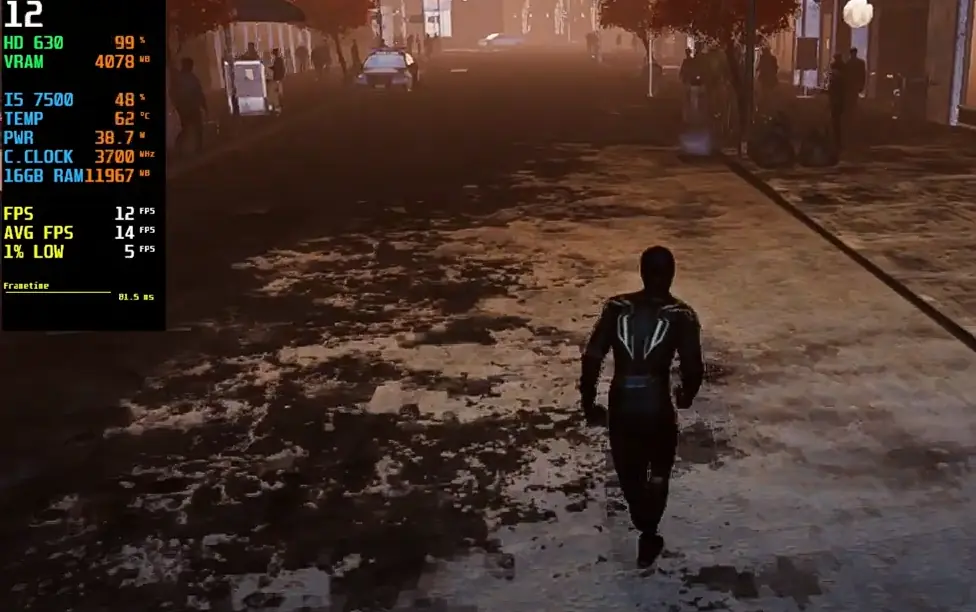
- Average Frame Rate: 14 FPS
- Minimum Instantaneous Frame Rate: 5 FPS
- Frame Time: 81.5ms
- CPU usage: 48%
- Power Consumption: 38.7W
- CPU Temperature: 62 degrees
- Memory usage: 12.0GB
- GPU usage: 99%
- VRAM usage: 4078MB
In this game, the CPU usage is close to 50%, memory usage is around 12GB, and the GPU is almost fully utilized, with VRAM usage exceeding 4GB.
Regarding the average frame rate, it can only reach around 14 FPS, with a frame time exceeding 80ms, far from the threshold for smooth gameplay.
③ The Third Game is “Tomb Raider (2013)”
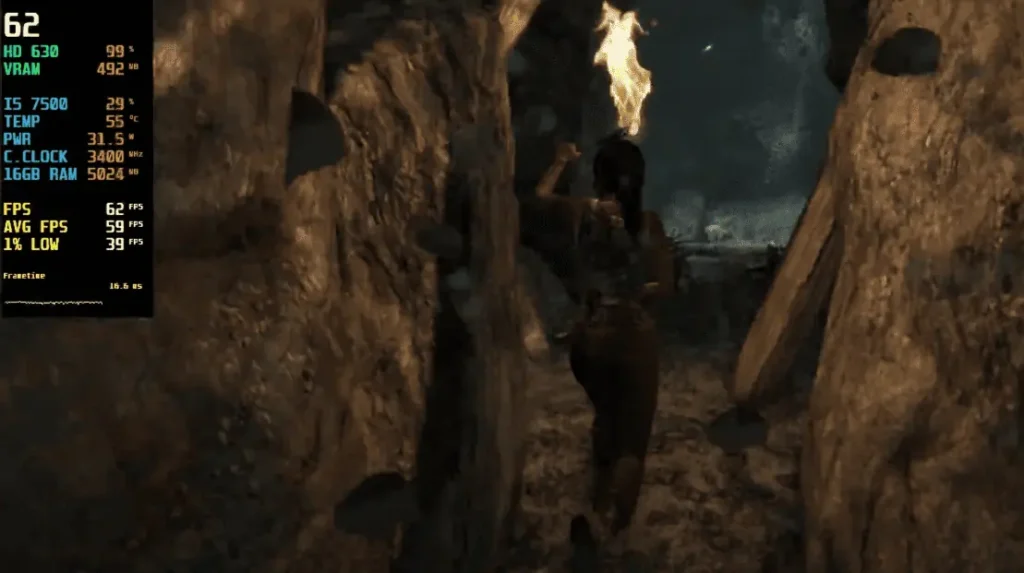
- Average Frame Rate: 59 FPS
- Minimum Instantaneous Frame Rate: 39 FPS
- Frame Time: 16.5ms
- CPU usage: 29%
- Power Consumption: 31.5W
- CPU Temperature: 55 degrees
- Memory usage: 5.0GB
- GPU usage: 99%
- VRAM usage: 492MB
In this game, the CPU usage is close to 30%, memory usage is around 5GB, and the GPU is running at full load, with VRAM usage below 500MB.
Regarding the average frame rate, it can achieve over 50 FPS, with the minimum instantaneous frame rate also above 30 FPS. The frame time is around 16ms, showing overall good performance and smooth gameplay.
④ The Fourth Game is “Days Gone”
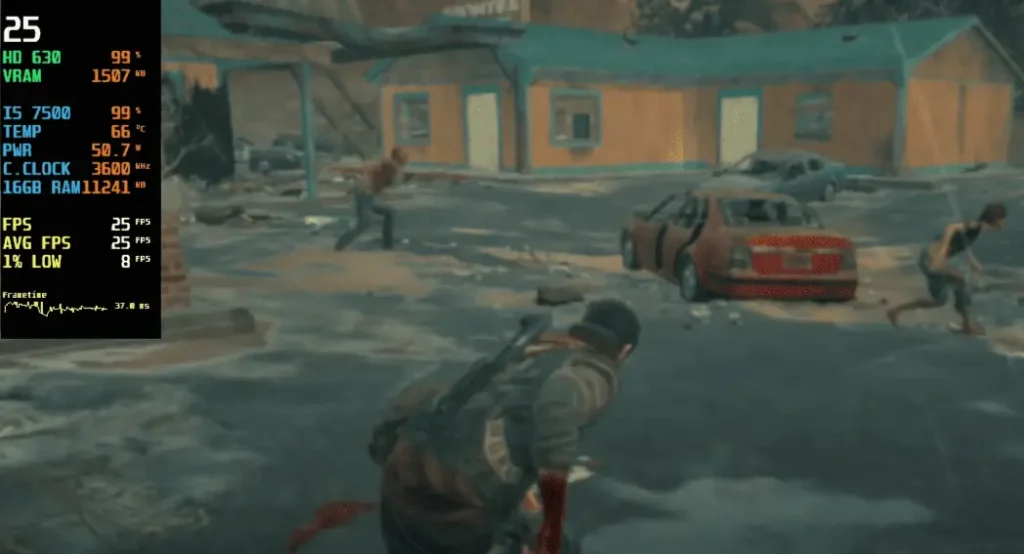
- Average Frame Rate: 25 FPS
- Minimum Instantaneous Frame Rate: 8 FPS
- Frame Time: 37.0ms
- CPU usage: 99%
- Power Consumption: 50.7W
- CPU Temperature: 66 degrees
- Memory usage: 11.2GB
- GPU usage: 99%
- VRAM usage: 1507MB
In this game, the CPU usage is nearly maxed out, memory usage is slightly over 11GB, and the GPU is running at full load with VRAM usage around 1.5GB. Both CPU and GPU are essentially fully utilized, running at maximum capacity.
Regarding the average frame rate, it reaches around 25 FPS, with a frame time exceeding 30ms. Unfortunately, it falls slightly short of the threshold for the lowest smooth gameplay experience.
⑤ The Fifth Game is “Evil Within 2”
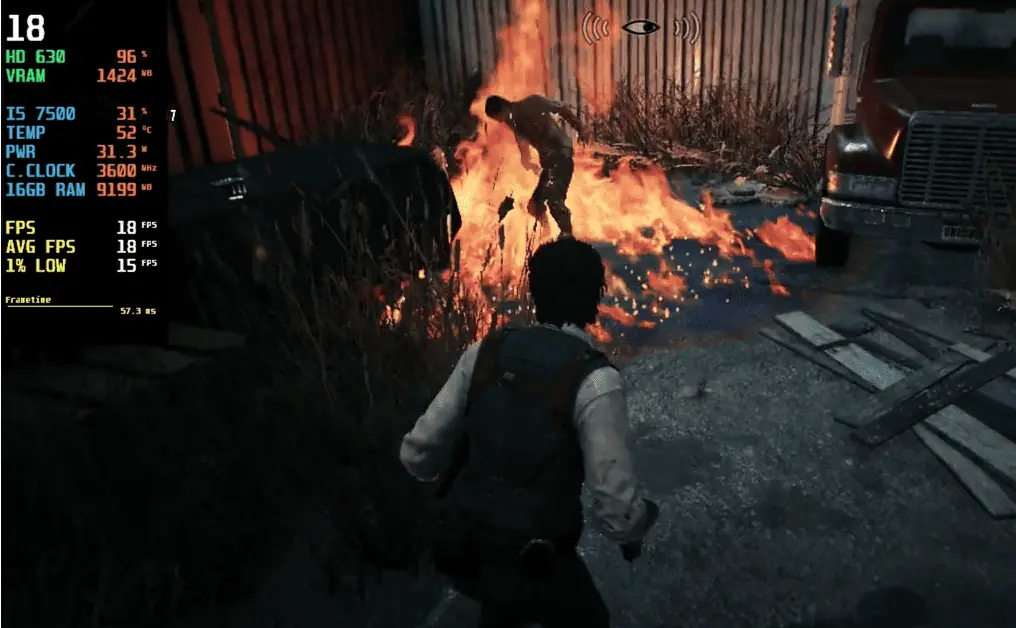
- Average Frame Rate: 18 FPS
- Minimum Instantaneous Frame Rate: 15 FPS
- Frame Time: 57.3ms
- CPU usage: 31%
- Power Consumption: 31.3W
- CPU Temperature: 52 degrees
- Memory usage: 9.2GB
- GPU usage: 96%
- VRAM usage: 1424MB
In this game, the CPU usage is only around 30%, memory usage is slightly over 9GB, and the GPU has about 4% of idle capacity, with VRAM usage around 1.4GB.
Regarding the average frame rate, it can only reach around 18 FPS, with a frame time exceeding 50ms, far from the threshold for the lowest smooth gameplay experience. As an aside, the author has been eagerly awaiting news about “Evil Within 3” for these past few years, but unfortunately, there has been no news or updates.
⑥ The Sixth Game is “Forza Horizon 5”
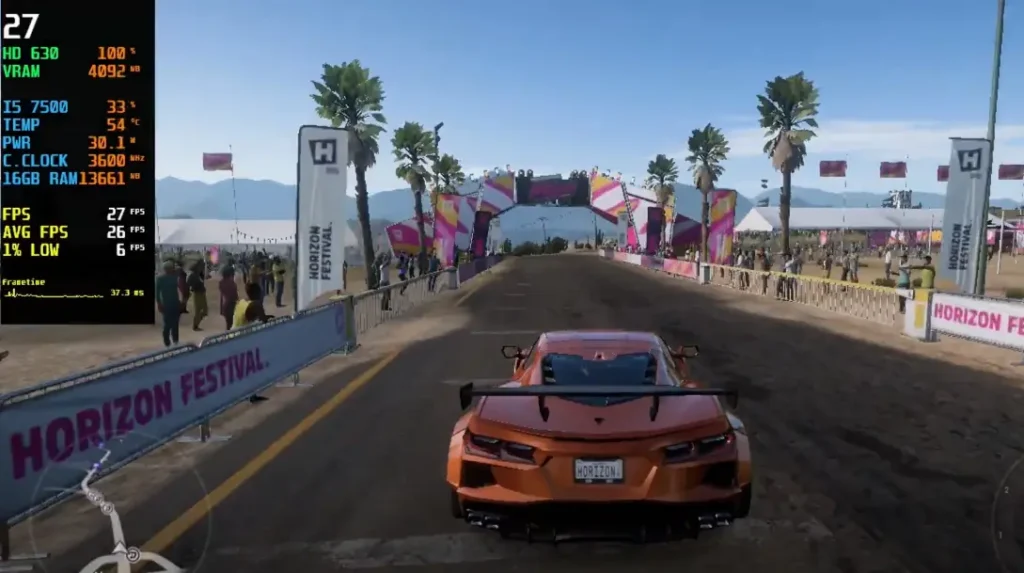
- Average Frame Rate: 26 FPS
- Minimum Instantaneous Frame Rate: 6 FPS
- Frame Time: 37.3ms
- CPU usage: 33%
- Power Consumption: 30.1W
- CPU Temperature: 54 degrees
- Memory usage: 13.7GB
- GPU usage: 100%
- VRAM usage: 4092MB
In this game, the CPU usage is just over 30%, close to one-third of its capacity. Memory usage is approaching 14GB, while the GPU is fully utilized at 100%, with VRAM usage around 4GB.
Regarding the average frame rate, it reaches around 26 FPS, with a frame time exceeding 30ms, falling slightly short of the threshold for the lowest smooth gameplay experience.
⑦ The Seventh Game is “Cyberpunk 2077”
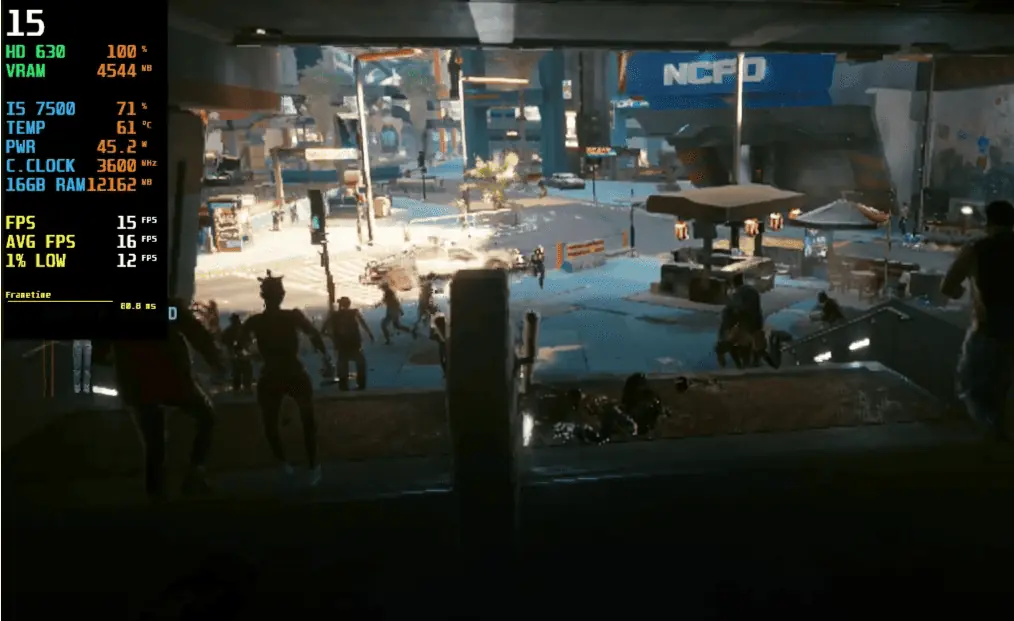
- Average Frame Rate: 16 FPS
- Minimum Instantaneous Frame Rate: 12 FPS
- Frame Time: 80.8ms
- CPU usage: 71%
- Power Consumption: 45.2W
- CPU Temperature: 61 degrees
- Memory usage: 12.2GB
- GPU usage: 100%
- VRAM usage: 4544MB
In this game, the CPU usage is around 70%, memory usage is around 12GB, and the GPU is fully utilized at 100%, reaching its maximum capacity, with VRAM usage around 4.5GB.
Regarding the average frame rate, it can only reach around 16 FPS, with a frame time exceeding 80ms, significantly far from the threshold for the lowest smooth gameplay experience.
04
Test Conclusion
The performance of the HD Graphics 630 is certainly insufficient for smooth gameplay in the aforementioned games. This outcome is entirely expected and within predictions. However, its actual performance exceeds the author’s initial estimations by a bit.
It’s notably more powerful than a basic “onboard display card.” While it’s incomparable to the performance of a dedicated graphics card, it remains adequate for office work and light entertainment. Respect for its capabilities is still warranted.

Related:








